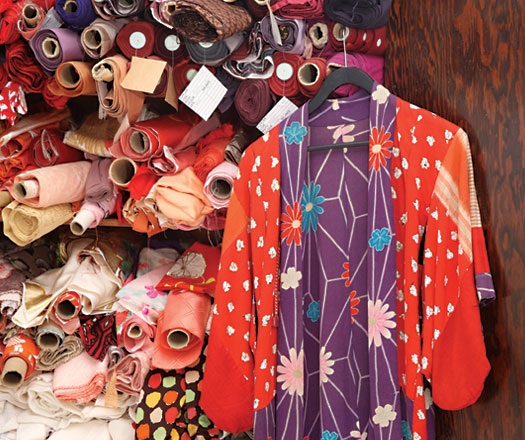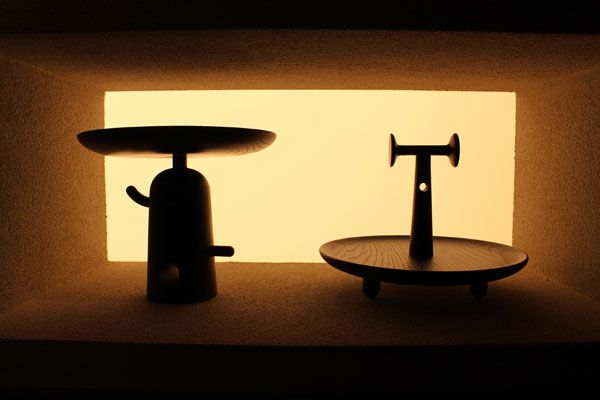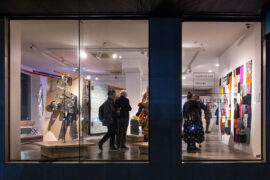We visit renowned fashion designer, Akira Isogawa, on location in his studio, where there are an array of beautiful things to be found.
October 16th, 2008
The following is an exerpt from Habitus magazine – the newest, most exciting magazine of 2008. Pick up your copy today from all good newsagents and book stores, or subscribe online here.
Akira Isogawa is one of Australia’s most recognized fashion designers, with his Japanese-inspired collections sought after in every fashion capital in the world. Penny Craswell visited his Sydney studio to find how design figures in his life and to find out his five favourite things and places in his adopted home town, Sydney.
Photography: Paul Lovelace
Akira Isogawa has just returned from showing his latest collection in Paris and is busy preparing for more catwalk shows. There are only five weeks to go until the event and his studio is abuzz with activity. Heading past the main room where his staff are busy at work, I am welcomed into a separate studio, where Akira spends much of his time hand-drawing ideas for the collection. He is softly-spoken and there are moments of silence while he concentrates on questions and decides how best to answer them. However, once he
gets going, it is obvious that he is passionate about his work.
When asked about the mayhem involved in creating a collection in under two months, he makes it clear that even though his work is shown regularly – twice a year in Paris and once a year in Melbourne – the work is not made to fit around the shows. Akira explains: “Even though I call it a new collection, for me, showing new work is a continuation of what I have done previously. I can’t just cut the thread from one collection to the other, because I am presenting who I am through my work.”
Akira’s work is very attuned to who he is. He moved to Sydney as a young man, studying fashion at the Sydney Institute of Technology and then launched his Sydney boutique in 1993. But even though his career has been in Australia, he is still very connected to his Japanese roots.
He fondly remembers growing up in Kyoto, where he was “surrounded by fabrics”, including the kimonos that his mother and grandmother wore. In turn, his designs are heavily based on this, often taking inspiration from the patterns, colours and fabrics of vintage kimonos. Taking these cues, he creates contemporary designs with modern shapes designed to be practical for the modern working woman: “Women who tend to like what I do are confident and independent. I want to make something that those women feel is useful and comfortable to wear. I’m inspired by strong women.”
Akira’s love of craftsmanship means that beautifully-worked textiles are also key to his work. One of the pieces in his current collection features hand-painted wooden sequins sourced from a trip to the sub-continent. “I made a trip to India and I found a textile manufacturer who produces prints, hand-crafted textiles such as beading and embroideries,” he says. The sequins were then stitched onto silk, with Akira specifying a pattern often found in vintage kimonos. They were even able to be stitched in such a way that the sequins can be flipped over to reveal a different coloured surface underneath. The effect is beautifully tactile. “I didn’t stitch the sequins myself, but have been fortunate to be able to be in touch with artisans who are able to produce such beautiful work.”
The next question: “What role does design play in your life?” is a difficult one to answer…
To read the rest of this and other great articles get your copy of Habitus from newsagents now, or subscribe here.

INDESIGN is on instagram
Follow @indesignlive
A searchable and comprehensive guide for specifying leading products and their suppliers
Keep up to date with the latest and greatest from our industry BFF's!

Rising above the new Sydney Metro Gadigal Station on Pitt Street, Investa’s Parkline Place is redefining the office property aesthetic.

London-based design duo Raw Edges have joined forces with Established & Sons and Tongue & Groove to introduce Wall to Wall – a hand-stained, “living collection” that transforms parquet flooring into a canvas of colour, pattern, and possibility.

In tribute to the life and oeuvre of Le Corbusier, Cassina presents a bold collection of wooden tables in which Jaime Hayón takes inspiration from Le Corbusier’s architecture and esprit nouveau artwork.

The design of 263-279 Broadway SJB with Land and Form Studios has been announced as the winner of a competition held by City of Sydney. It’s set to redefine student living in the heart of Glebe.
dedece is offering up to 70% off sale items from Thursday 17 March to Saturday 19 March. Products from Knoll, Minotti, Tom Dixon, Cappellini, Vittorio Bonacina, and Normann Copenhagen are just some of the items up for grabs. The dedece showroom at 253 Liverpool Street, Darlinghurst, Sydney will be open between 9am and 5pm. […]
The internet never sleeps! Here's the stuff you might have missed

With Steelcase having reopened its refreshed WorkLife Showroom in Singapore this year, we spoke to Navedita Shergill about some key workplace macro shifts identified in their research.

The Australian Design Centre (ADC) has announced that the organisation can no longer continue without adequate government funding to cover operational costs.